Country Report
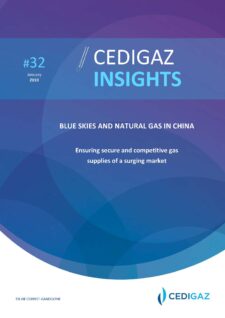
BLUE SKIES AND NATURAL GAS IN CHINA
Cedigaz Insights N° 32 January 2019 101 pages PDF format
The Chinese gas market has entered a new phase of growth driven by favourable policies. A complete report on the Chinese booming gas market, this CEDIGAZ Insight special issue covers demand, production (including Shale gas and other unconventional gas productions), imports from pipelines and LNG, Chinese energy policies, infrastructure development, medium and long-term Outlook and more.
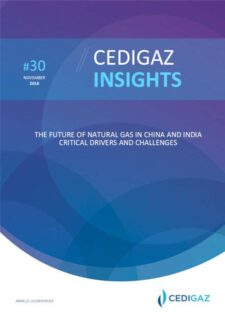
The Future of Natural Gas in China and India - Critical Drivers and Challenges
"Cedigaz Insights N° 30 November 2018 32 pages PDF format"
Accelerated reforms and focused policies aimed at increasing the role of gas and renewables in the energy mix combine to improve the natural gas demand outlook of China and India
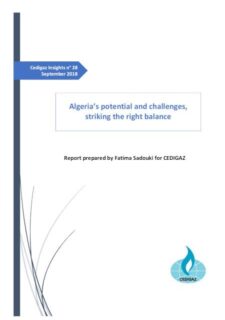
Algeria's potential and challenges, striking the right balance
Cedigaz Insights N° 28 September 2018 46 pages PDF format
| Member | FREE | Login |
| Non Member | 1000 € |
Algeria is facing a new crossroad as its political and socio-economic balance has become increasingly weakened by the consequences of the oil price collapse since 2014. Algeria is faced with stark choices, as illustrated by the interplay between its energy sector and its political & economic challenges and opportunities. Budgetary constraints are putting pressure on its key hydrocarbon industry, which was already suffering from years of underinvestment due to tough fiscal terms, challenging business climate and security risks. The North African nation needs to intensify efforts to revive its oil and gas upstream sector with new projects, avert the long-term production decline at mature fields, whilst meeting growing domestic demand and honoring gas export commitments. The widening fiscal deficit and the rapid erosion of financial buffers since the oil price fell is further increasing the need for foreign capital to boost oil and gas reserves, amid growing competition with other producing nations to attract capital and technical know-how from international oil companies. But the lack of upstream investment is just one of the challenges facing Algiers in its energy sector and beyond.
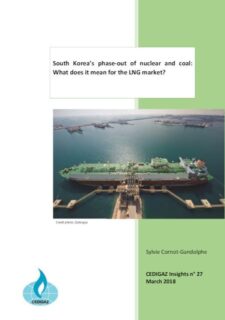
South Korea's phase-out of nuclear and coal: what does it mean for the LNG market?
Cedigaz Insights N° 27 March 2018 43 pages PDF format
| Member | FREE | Login |
| Non Member | 1000 € |
Shortly after his inauguration in May 2017, the new President of South Korea has unveiled a new energy policy that shifts away from nuclear and coal power and focuses on renewables and natural gas instead. The move responds to growing safety concerns over nuclear power following the 2011 Fukushima accident and a series of earthquakes that hit southern Korea in 2016 and 2017. The energy transformation also responds to rising public hostility to coal power due to worsening air quality. Coal burning is also the main source of greenhouse gas emissions in the country, which has committed to reduce its emissions by 37% by 2030.
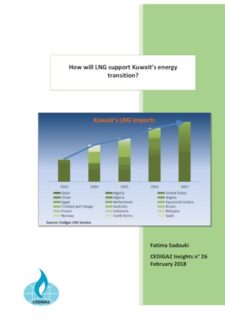
How will LNG support Kuwait's energy transition?
Cedigaz Insights N° 26 February 2018 42 pages PDF format
| Member | FREE | Login |
| Non Member | 1000 € |
Kuwait is mostly known as one of the world's largest oil producing nations and as a leading member of OPEC. But the country was also a pioneer in 2009 when it became the first in the MENA region to import LNG via a floating storage and regasification unit. At the time, LNG was considered a stop-gap solution to address chronic electricity shortages that threatened Kuwait's economic and socio-political stability. Today, Kuwait continues to lead the way in the region by being the first LNG importer to invest in a land-based LNG import terminal. The 22 mtpa facility, for which construction has begun at Al Zour industrial area, is scheduled to come online in 2021. Cedigaz's latest report examines the risks and opportunities of Kuwait's LNG strategy.
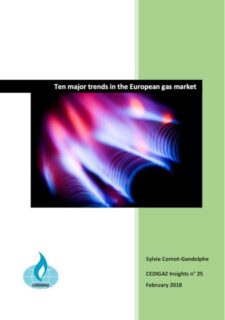
Ten major trends in the European gas market
Cedigaz Insights N° 25 February 2018 46 pages PDF format
The EU gas and energy sector is in the midst of a profound transformation driven by decarbonisation, digitalisation and decentralisation. The latest report by Cedigaz analyses in ten key points the evolution of the gas sector and includes forward looking views on new trends in EU gas markets.
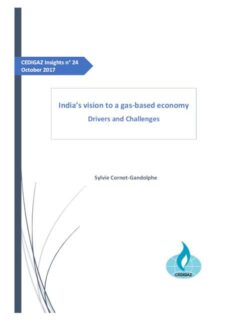
India's vision to a gas-based economy, drivers and challenges
Cedigaz Insights N° 24 October 2017 16 pages PDF format
Thanks to India's rising economy and population, the country's outlook for growth in energy demand is robust. The role of gas in the country's energy mix, however, is hard to determine. Today, India's primary energy mix is dominated by coal and oil. The role of natural gas is limited: only 6% in 2016. But the government wants to make India a gas-based economy and raise the share of natural gas in the energy mix to 15% by 2022, although the timing remains uncertain. This paper analyses gas demand trends in India by 2025-30 and draws on two reports recently published by the Oxford Institute for Energy Studies (OIES) and the Bureau of Economic Geology (BEG)/Centre for Energy Economics (CEE), University of Texas. Gas consumption in India is driven by five sectors: fertilizer (34% of total gas demand in fiscal year 2015-16), electric power (23%), refining (11%), city gas distribution, including transport (11%), and petrochemical (8%) industries. In 2016, after five years of consecutive declines, gas consumption increased to 55 bcm, boosted by sales to city gas distribution mainly. The country faces a widening gap between indigenous gas production and demand, which is met by increasing Liquefied Natural Gas (LNG) imports. LNG imports surged by 34% over 2015 to 25 bcm in 2016, making India the fourth largest importer in the world.
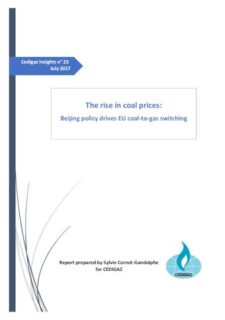
The rise in coal prices: Beijing policy drives EU coal-to-gas switching
Cedigaz Insights N° 23 July 2017 23 pages PDF format
Despite a decline in global coal demand for the second consecutive year, international steam coal prices doubled in 2016. This massive rise may seem paradoxical; in fact, it responded to market fundamentals: a tightening of the international market due to an unexpected surge in Chinese coal imports and the inability of exporters to meet this sudden increase. The surge in Chinese imports was not due to increasing demand – Chinese coal consumption in 2016 fell for the third year in a row– but to domestic production restrictions mandated by the Chinese government from April 2016. To remove excessive and outdated capacities in the domestic coal sector, that weighed on domestic coal prices, the government required coal mining companies to cut operating days from 330 to 276 a year. The new regulation led to a fall in coal production, shortages of coal and a steep increase in domestic coal prices, forcing power utilities to turn to the international market. However, after five years of low prices and reductions in investment, exporters were not able to respond to this sudden demand and international prices increased to clear the market.
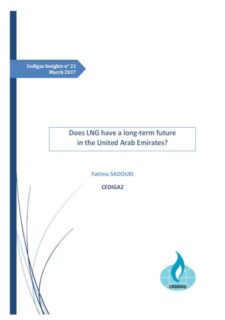
Does LNG have a long-term future in the United Arab Emirates?
Cedigaz Insights N° 21 March 2017 30 pages PDF format
The United Arab Emirates (UAE) is one of the world's longest-established LNG exporters. But despite holding the world's sixth largest gas reserves, LNG imports into the federation increased at an impressive rate since 2010, when the Jebel Ali floating terminal in Dubai started up. With gas representing more than 90% of the power fuel mix, LNG purchases have been key to fill a widening supply deficit in order to match rapidly growing gas-to-power demand. Today, LNG remains at the heart of the UAE's strategy to meet rising energy consumption and support economic and industrial expansion in times of reduced oil income and budgetary constraints. Cedigaz's latest report examines the risks and opportunities inherent to this strategy and asks whether it is viable in the medium to longer term.
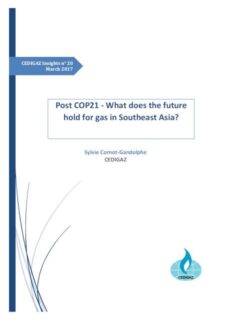
Post COP21 - What does the future hold for gas in Southeast Asia?
Cedigaz Insights N° 20 March 2017 37 pages PDF format
Controlling greenhouse gas (GHG) emissions and other environmental impacts while ensuring safe and affordable energy for all are the major challenges faced by Southeast Asia. To respond to these challenges, the Association of Southeast Asian Nations (ASEAN) is increasing the share of renewable energy sources in its energy mix and implements measures to reduce its energy and carbon intensity. Surging energy and electricity needs mean that fossil fuels will continue to dominate the energy and electricity mix by 2040. While natural gas is an ideal fuel to reduce the environmental footprint of power generation, competition with coal, stagnation in gas production, lack of adequate infrastructure, have been major barriers to its increased use so far. Southeast Asia has turned to coal instead, which has been the fuel of choice for power generation in the past ten years due to its low cost and ample availability in the region. But as electricity demand is expected to continue surging, and with a growing concern over air pollution and CO2 emissions, the dominance of coal in the Southeast Asian power sector is increasingly called into question.
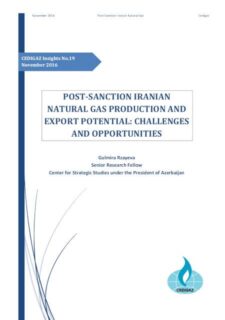
Post-Sanction Iranian Natural Gas Production and Export Potential: Challenges and Opportunities
Cedigaz Insights N° 19 November 2016 66 pages PDF format
Iran owns the world’s second largest proven gas reserves holding 34 trillion cubic meters of gas. However historically the country has not been able to fully benefit from its huge potential and become a major player in the global gas trade for a number of reasons, mainly the imposed US and international sanctions and an internal legal and contractual regime unfavorable for investment. This has made the country unable to capitalize on its huge natural gas reserves and to duly develop its energy industry potential.
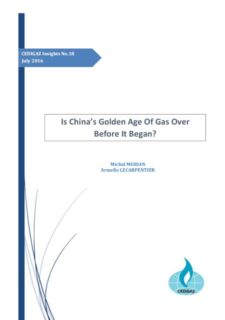
Is China's Golden Agen Of Gas Over Before It Began?
Cedigaz Insights N° 18 July 2016 18 pages PDF format
Up until not long ago, China’s gas story had been one of soaring demand and insufficient supplies. But since 2014, due to its economic slowdown and the collapse in oil prices, China’s gas market has swung into oversupply. Despite Beijing’s ambitious fuel switching agenda from coal to gas, domestic prices will continue to cripple demand and the government’s consumption targets of 230-260 bcm in 2015 and 360-400 bcm in 2020 will not be met. The author expects China’s gas demand to reach 190 bcm in 2015 and 270-280 bcm in 2020.
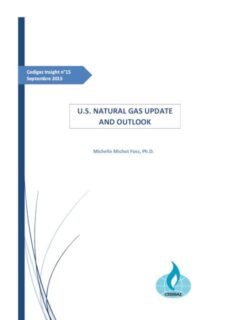
U.S. Natural Gas Update and Outlook
Cedigaz Insights N° 15 September 2015 66 pages PDF format
The oil price decline has left American producers in a situation like that of 2009 following the collapse of the Henry Hub gas prices. At the time, shale gas production was growing fast but demand was depressed due to the effects of the subprime mortgage crisis. Producers reacted by redirecting their investments towards liquid-rich deposits (containing oil or natural gas liquids) and were thus able to benefit from the oil price recovery. This strategic reorientation did not penalize gas production, which continued to grow, thanks to the gases associated with oil production which, in recent years, have been responsible for almost all growth in gas production. Today, more than 50% of the shale gas produced in the United States comes from liquid-rich deposits. Consequently, any decrease in liquids production occurring in reaction to falling oil prices is bound to have major repercussions on domestic gas production.
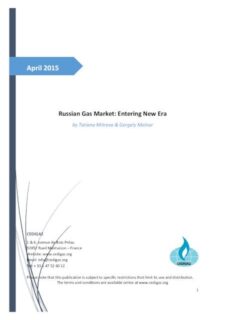
Russian Gas Market: Entering New Era
Cedigaz Insights N° 14 April 2015 80 pages PDF format
After a period of extensive growth in the 2000s, the Russian gas industry is now facing numerous challenges. Mounting competition by independent producers and the development of new production by Gazprom, combined with stagnating domestic demand and weakening export markets, have created a situation of overproduction, made worse by western sanctions and low oil and gas prices. Expansion to the East thanks to the recent China deal is not expected to provide much relief before 2024. The coming decade will be critical for the industry and its outcome will largely depend on the government's pricing and institutional policies but the role of the state should remain essential.
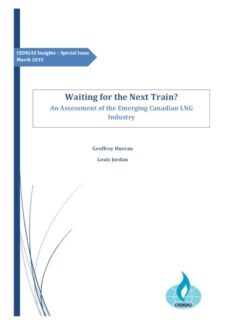
Waiting for the Next Train? An Assessment of the Emerging Canadian LNG Industry
Cedigaz Insights - Special issue March 2015 50 pages PDF format
In February 2015, Canada counted 22 LNG liquefaction plant projects – of which 17 are located in British Columbia – representing a total design capacity of 325 mmtpa. Canada has the potential to become a major LNG exporter but no project has received Final Investment Decision (FID) so far. Competition with US brownfield projects with innovative business models have limited the commercial appeal of many Canadian projects relying on oil indexation. More recently, plummeting oil prices have put into question their profitability and lead to several postponements of FID reviews. CEDIGAZ’s new report Waiting for the Next Train? An Assessment of the Emerging LNG Industry in Canada discusses the potential for Canada to export LNG, looking at the initial enthusiasm and wide support by public authorities and local communities but also at the economic challenges and commercial issues that are slowing the progress of these projects.
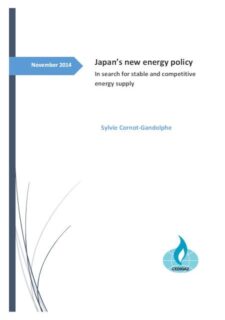
Japan's New Energy Policy - In search for stable and competitive energy supply
Cedigaz Insights N° 13 November 2014 66 pages PDF format
Japan's energy policy is undergoing fundamental changes. The accident at TEPCO's Fukushima Daiichi nuclear power plant questions the future contribution of nuclear power in the national energy mix. Growing imports of fossil fuels to replace the lost nuclear capacity inflated energy prices and raise economic and energy security challenges. At the same time, the US shale gas and oil revolution is reshaping the global energy scene. Japan expects to take advantage of the trend to eliminate the “Asian premium” on natural gas prices and expand cheaper natural gas consumption. These developments have driven the Government of Japan to review its energy policy from scratch and adopt a new Strategic Energy Plan. This new policy has far reaching implications for gas and coal development in Japan but also for the international markets as Japan is the world's largest LNG importer and the second largest coal importer.



